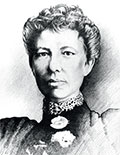Dame Mary Gilmore (1865–1962)

Author, journalist, poet, patriot and campaigner against injustice and deprivation.
Dame Mary Gilmore was a founding member of the Fellowship of Australian Writers and Sydney's Lyceum Club and was active in organisations as diverse as the New South Wales Institute of Journalists and the Aboriginal Australian Fellowship. A highly popular and nationally known writer, Dame Mary Gilmore was a celebrated public figure: Sydney's literati gathered annually to celebrate her birthday; awards and scholarships were given in her name; and radio broadcasts and public appearances commanded her time.
1865: Dame Mary Gilmore was born on 16 August 1865 at Cotta Walla (near Goulburn), New South Wales, the eldest child of Donald and Mary Ann (nee Beattie) Cameron. She was educated mainly at small country schools in the Wagga Wagga district.
1883: In January 1883, Gilmore became a pupil teacher at the Superior Public School, Wagga Wagga.
1886–1895: She served as a school teacher at Beaconsfield, Illabo, Silverton, Neutral Bay and Stanmore. Gilmore's desire for social reform gained political momentum in the radical and nationalist ferment of the 1890s. Sensitive to the conventions of the day, Gilmore protected her teaching career during this time by writing under pen-names, including Em Jaycey, Sister Jaycey and Rudione Calvert.
1895: Inspired by William Lane's ideal of utopian socialism, Gilmore joined the New Australia Movement and contributed regularly to its journal before departing for Cosme, Paraguay, in November 1895. While there she edited the daily journal, Cosme Evening Notes.
1897: She married William Alexander Gilmore and the following year gave birth to their only child, William Dysart Cameron Gilmore.
1902: Disillusioned with the breakdown of the Cosme community and the departure of William Lane in 1899, the Gilmores returned to Australia in 1902 and lived at Casterton, Victoria.
1908: Henry Lammond, editor of the Australian Worker, responded to Gilmore's request for a special page for women by inviting her to write it herself. The column was very popular, with Gilmore remaining editor of the Women's page until 1931. Through the column, Gilmore campaigned for a wide range of social and economic reforms, such as voting rights for the women, old age and invalid pensions, child endowment, the relief of the poor and the just treatment of Aboriginal people.
1912: Gilmore moved to Sydney with her son Billy, while her husband William established the first of the family properties at Cloncurry in North Queensland.
1928: She was a founding member of the Fellowship of Australian Writers.
1937: She became the first person to be appointed Dame Commander of the British Empire for contributions to literature.
1940: During World War II, Gilmore captured the hearts of Australians with a stirring call to patriotism in the poem ‘No Foe Shall Gather Our Harvest’.
1942: She criticised the Allies in the fiery poem ‘Singapore’.
1952: Gilmore commenced a regular column, ‘Arrows’, for the Tribune, where she vented her egalitarian and democratic views until shortly before her death in 1962.
1961: Australian Trade Unions honoured Gilmore's contribution to the labour movement, crowning her May Queen for the May Day procession.
1962: Dame Mary Gilmore died on 3 December 1962. Three days later, Sydney witnessed the first state funeral accorded to an Australian writer since the death of Henry Lawson 40 years earlier.
Note: Gilmore published numerous volumes of prose and poetry. A selection of her work includes: Marri'd and Other Verses (1910), The Tilted Cart (1925), The Wild Swan (1930), Under the Wilgas (1932), Battlefields (1939) and Fourteen Men (1954). Frontier society was the subject of her prose works, The Hound of the Road (1922), Old Days, Old Ways (1934) and More Recollections (1935).
Further information is available in Notable Australians.